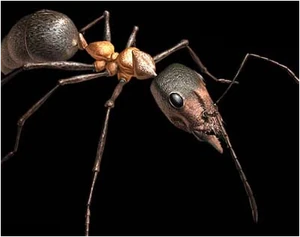
Formicium is a giant ant from the Early Eocene Epoch and are bigger than modern ants by far. They were the largest ants of all time, with workers and wingless soldiers around 5 cm long and the Queen and her winged soldiers up to 8 cm in wingspan.
Description[]
They were carnivorous and would have behaved as modern army ants, maintaining a large territory with massive numbers going on regular foraging raids into the undergrowth and even perhaps attacking prey up the trees.
As with modern ant species, though many could be eaten in turn by large spiders and other such predators, eventually, sheer weight of numbers would destroy anything in their path. Even larger animals like lizards, mammals and birds could have been at some serious risk. Hundreds of thousands, if not millions of individuals over 2-3 inches long, were a terrifying prospect. Even Gastornis, the 1.75-2 metre tall, half tonne bird of terror, would have probably avoided or fled from a large army of Formicium on the hunt.
There was very little defence any single animal could put up against the vast swarms of biting giant ants. Various specimens are known from Messel and Geistel in Germany. They lived around 49 Million Years Ago as such; though no fossil evidence has yet been found to extend their time range any further than this, it is likely they or at least ants like them lived throughout the Palaeocene and Early Eocene Epochs.
Walking with Dinosaurs[]
These ants never appeared in Walking with Dinosaurs
Walking with Beasts[]
They were seen in Walking with Beasts in episode 1 where a huge army has devoured a young Gastornis and the mother returned and saw that her chick has been eaten by the army of the ants. Formicium were killed by the carbon dioxide possibly, though this is not shown. When the Leptitictidium found the dead Ambulocetus, a Formicium scout was crawling over the corpse already. Formicium also appeared in Animal Planet: The Most Extreme in Awsome Ancestors where they were bigger than modern ants.